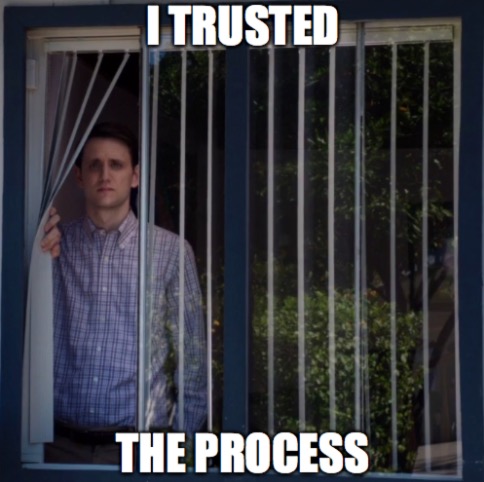Ad Disclosure
We’ve Gone Too Far
By Kyle Scott
Published:

 This post is brought to you with limited advertising and no surveys by Michael Parisano. Are you looking to buy or sell your home? Are you a first time buyer looking to buy your first home? If the answer to one of those questions is “yes,” please consider contacting Michael Parisano of Coldwell Banker Preferred. Over 70% of Michael’s clients are first time buyers. Michael Parisano is a native of Delaware County and a graduate of Cardinal O’Hara High School & Temple University. He works with buyers, sellers, renters, and landlords throughout the city of Philadelphia, Delaware County, Chester County, and Montgomery County. Michael is driven, honest, and always strives to be the hardest worker in the room. His main goal is to help his clients find their dream home and to make that process as stress free as possible. Please contact Michael at MParisano@cbpref.com or call him at 610-348-9931.
This post is brought to you with limited advertising and no surveys by Michael Parisano. Are you looking to buy or sell your home? Are you a first time buyer looking to buy your first home? If the answer to one of those questions is “yes,” please consider contacting Michael Parisano of Coldwell Banker Preferred. Over 70% of Michael’s clients are first time buyers. Michael Parisano is a native of Delaware County and a graduate of Cardinal O’Hara High School & Temple University. He works with buyers, sellers, renters, and landlords throughout the city of Philadelphia, Delaware County, Chester County, and Montgomery County. Michael is driven, honest, and always strives to be the hardest worker in the room. His main goal is to help his clients find their dream home and to make that process as stress free as possible. Please contact Michael at MParisano@cbpref.com or call him at 610-348-9931.
I’ve been thinking about writing this post for a little while now.
Six years ago, in 2011, each of the four major sports teams in Philly were perhaps the most antiquated in their respective leagues.
The Phillies were in the midst of their historic run and were, as it turns out, the last team in Major League Baseball to have a sustained period of success and win the old-fashioned way (with good pitching and the three-run homer). They had fully gutted their farm system in an attempt to keep open their window of opportunity.
The Eagles were in the doldrums of the end of the Andy Reid era, which had stalled itself into a frustrating tailspin filled with the same predictable cock-ups that plagued Reid’s entire tenure here.
The Flyers had just signed Ilya Bryzgalov to a $51 million contract.
And the Sixers were still owned by Comcast, which seemed content to let the team play itself to an eight seed every year.
In this old school, stubborn town, our teams were a reflection of the city– resistant to change, archaic in their thinking, and the real-world equivalent of a government website designed in 1998. The Phillies were basically an animated GIF that said “Print!” in big green letters.
There was a groundswell, particularly from Phillies Twitter, of support for the local teams to embrace analytics or otherwise turn the page. Each team, perhaps reacting to their untenable existence and public outcry, swung the pendulum about as far forward as it could go.
The Eagles became the first to do so, in 2013 hiring Chip Kelly, who implemented what can loosely be defined as football and initiating a wave of sports science and nutrition advancements at the NovaCare Complex, ridding the place of Taco Tuesdays, Whiskey Wednesdays, Tortuga Thursdays and Fat Ass Fridays.
Then the Sixers followed suit, when Joshua Harris bought the team and hired Sam Hinkie, who undertook maybe the most progressive endeavor in NBA history with his tanking and a process that literally resulted in him writing a deranged yet brilliant 13-page manifesto as he rode off into the sunset, which was actually a home in Silicon Valley, where Hinkie has since shaved his head, grown a beard, and basically turned into Gavin Fucking Belson.
Then it was the Flyers, who oddly promoted failed GM Paul Holmgren to President and tapped Ron Hextall as their savior GM. Ironically, one of the most OB players of all-time, THE FLYERS FIGHTING GOALIE, was tasked with recreating the way the franchise did its business, by building through the draft and off-loading the downright idiotic contracts handed out by his predecessor and boss.
And then the Phillies came around, firing Ruben Amaro, bringing in Andy MacPhail and Matt Klentak as John Middleton Game of Throned his way into becoming the controlling owner, and embracing analytics, which are now a necessity for every team in baseball. Since then, the Phils have undertaken their own tank of sorts.
In a way, you can say that each of the teams – especially the Eagles and Sixers – became the most progressive in their respective sports. But how has it worked out?
The Sixers are obviously and clearly positioned to become a great team, with an infrastructure and business arm to match. If they can keep their young players healthy, it’s possible they can become the model for a successful sports franchise– winning team, premium facilities, excellent branding, a diverse business portfolio (e-sports, incubator), and a highly-profitable sales structure.
However, despite the fertile land in which their seed is being gestated, even they went too far. Old-timers in the city revolted. The league and other owners got squeamish about Hinkie, forced Harris’ hand to fire him, and the team brought in the league-approved Colangelos to run things. Bryan Colangelo will, undoubtedly, accelerate the process to some degree and return the team to some level of conventionality. But the fruits of Hinkie’s labor, developments in sports science, and investment in progressive business interests will remain. If we’re grading on a scale from 1 to 10, with 1 being OLD FASHIONED and 10 being JOAQUIN PHOENIX IN HER, the Sixers are sitting at a solid 8.
The results when it comes to the other teams are a bit less defined.
The Eagles realized that they swung the pendulum way too far. Like, off the meter into a binary simulation far. Kelly proved to be too much for the NFL. His emotional intelligence was nil, players accused him of being racist, pictures of Bart Simpsons turned out to NOT be the best way to signal plays, and, mostly, his offense was just flat-out predictable and bad in the NFL. Especially in a city like Philly, which is willing to let a mad scientist tinker with its basketball team but most definitely not the football team, Kelly was destined to fail. Of course, he didn’t have much more success in San Francisco. Actually, he didn’t have any success and now he’s on ESPN.
Jeffery Lurie acknowledged the error the only way he knew how: by turning the clock so far back that he rebuilt The Vet, undid the housing crisis, and made Judd Apatow relevant again.
Like the Sixers, the Eagles have kept vestiges of the more modern era– sports science and nutrition. But they are at no more on a 4 on our 10-point scale.
The Flyers made the welcomed change to stop trying to buy and bruise their way to a Stanley Cup every year and undertook a more measured approached. Thus far, the results are mixed at best. They do have a plethora of young talent, but they regressed in the second season under science project head coach Dave Hakstol. Their remaining core, which is now in its supposed prime, has won one playoff series in five years. And the biggest trump card they own, the second pick in the draft this year, was obtained through dumb luck. They are positioned to be good over the next few years, but they are one more missed playoffs from both Ron Hextall’s and certainly Dave Hakstol’s jobs being on the line. And then what?
The Flyers are maybe a 6 on our scale.
And then there’s the Phillies. Holy fuck there’s the Phillies. Baseball, more than any other sport, requires patience if you’re going to build through the draft. Like, maybe 20 years patience. More than the other three sports, it is very difficult to predict draft success and player development in baseball. It has only been two years since Klentak has had a chance to make his mark. But worse than the positively awful on-field product is the fact that the Phillies’ most recent batch of future stars look like anything but, and their minor league prospects are hardly wow-ing so far this season. Worse, and more applicable to this topic, the Phillies have the means to buy their way into respectability while at the same time allowing their prospects to develop. And yet, this season, the product that has been put on the field – a combination of homegrown talent, acquired assets, and free agents – is purely dreadful, looks disinterested, and is a basic affront to sports fandom. Ruben Amaro certainly “did it wrong,” but there are no signs thus far that Klentak, his Newtown’s Third Law mandate, is doing it any better. The Phillies are maybe a 6 on our scale right now, but at times they feel like a 9 stuck in a 2’s body.
So what’s my point here? In just the span of a few years, Philly teams went from stubbornly old-fashioned to radically progressive. What we’ve learned, though, is that perhaps the best version of sports falls somewhere in the middle. Look at recent champions. Theo Eptstein, largely credited for being the first to win with analytics, in Boston, has said that the Cubs’ success is as much about human intelligence as it is newfangled thinking, partly because the edge in SABR is gone and a marriage of human observation and data is best. The Warriors, arguably the most progressive on-court product in basketball and maybe the greatest team ever, lost to superstardom, effort and size last year. On no planet were the Cavs better, but LeBron’s will to win trumped the Warriors’ three-point formula, which was rendered utterly useless the moment Steph Curry needed to be an Alpha male late in Game 7 and dribbled away their season into nothingness.
We’ve seen both ends of the spectrum, from maddeningly old school to shockingly, uncomfortably forward-thinking. Neither is best. The answer, as it always seems to be, is somewhere in the middle.
Kyle Scott is the founder and editor of CrossingBroad.com. He has written for CBS Philly and Philly Voice, and been a panelist or contributor on NBC Sports Philly, FOX 29 and SNY TV, as well as a recurring guest on 97.5 The Fanatic, 94 WIP, 106.7 The Fan and other stations. He has more than 10 years experience running digital media properties and in online advertising and marketing.